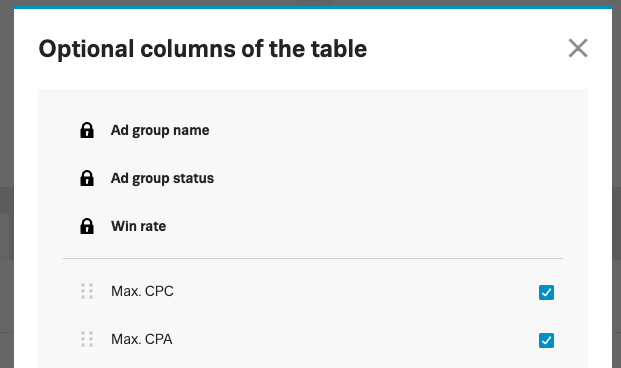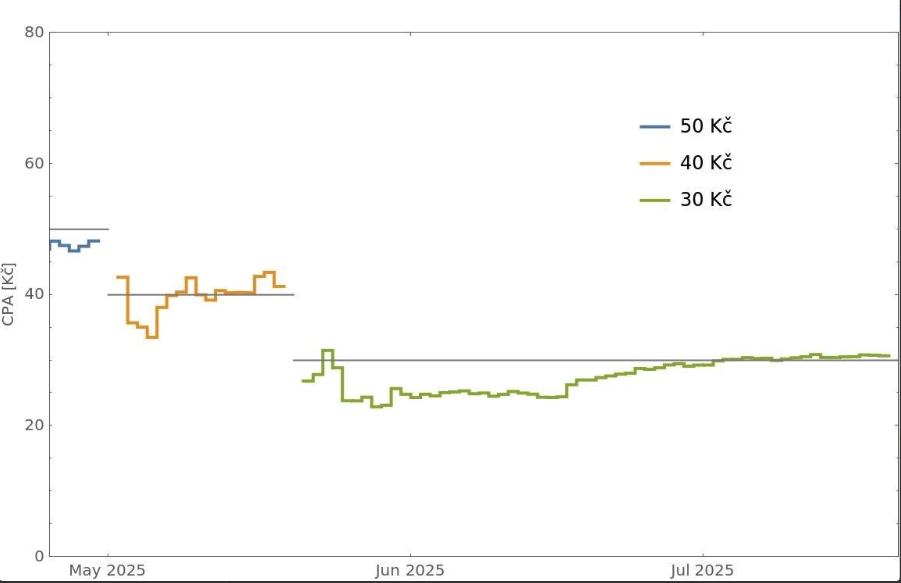Conversion maximization
- How does Conversion maximization work?
- What is good to know?
- How to set up Conversion maximization?
- How to evaluate Conversion maximization campaign?
- Frequently asked questions
- Planned development
How does Conversion maximization work?
In the campaign settings, change the bidding strategy to Conversion maximization and enter the maximum CPA (maximum Cost Per Action) you are willing to pay to get one conversion. The system then automatically sets the costs per click in auctions to maximize the number of conversions while staying within this maximum CPA.
How does it help you?
- Saves you time – there is no need to manually adjust max. CPC based on performance.
- Delivers better performance – maximizes impressions in auctions with a high probability of conversion and saves budget by avoiding auctions with low or no conversion potential.
Compared to automatic rules or external bidding tools, Conversion maximization in Sklik works in real time with many available signals. There are dozens of them – device type, browser, user gender and age category, ad format, targeting type, advertiser segment, ad zone, etc.
What is good to know?
- Conversion maximization now counts all tracked conversions regardless of their type (for example, if you are tracking both purchases and registrations).
- When Conversion maximization is activated, ads from the campaign are displayed on all devices, regardless of the multiplier settings and scheduled timing. The system automatically adjusts bids based on the predicted conversion on a particular device for a specific day and hour in each individual auction.
- If you want to activate Conversion maximization for a campaign, which is targeting only desktop devices and you have an identical campaign targeting only mobile devices, pause one of these campaigns, otherwise they will negatively impact each other in auctions.
- When Conversion maximization is turned on, the ad rotation method automatically changes to optimized based on CPA.
- If you switch the campaign back to the CPC or CPT bidding strategy, the previously set max. CPC will be restored. However, the multiplier will not be restored if it was set.
- In order to enable Conversion maximization, the campaign must have had at least 30 conversions in the last 30 days. In general, the more conversions a campaign has, the higher the chance of success. Before maximization can be activated, the campaign must be active for at least 7 days.
- Currently, the Conversion maximization is only available for Display and Product campaigns (Dynamic banner, Dynamic retargeting) in the Display network.
How to set up Conversion maximization?
1. In the campaign settings, change the bidding strategy to Conversion maximization and enter the required maximum CPA.
- Warning: If you set the maximum CPA lower than the current CPA achieved in the campaign, the campaign volume in terms of impressions, clicks, and possibly conversions will decrease.
- Do not test on a duplicate campaign where campaigns with max. CPC and max. CPA run side by side. Even if one of them is only supposed to be displayed on one device (e.g., mobile) – they will negatively affect each other.
2. In Sklik interface, you can choose to see the optional max. CPA column. You can also adjust these values for individual ad groups in a specific campaign. Ad group settings have priority over campaign settings.
Tip: You can save your column settings for use across all accounts and enable them only where they make sense in relation to your bidding strategies.
We recommend that the daily campaign budget should not be less than five times the set maximum CPA. A campaign that aims to drive conversions generally shouldn’t be limited by the daily budget, otherwise you might get fewer conversions than before you turned on Conversion maximization, because the most valuable clicks can cost tens of crowns more.
3. Evaluate the results of the campaign at least two weeks after launching the campaign or changing the maximum CPA.
How to evaluate Conversion maximization campaign?
Look at two key indicators:
- Whether the maximum CPA was met.
- Whether the campaign generated more conversions than it did before you turned on Conversion maximization.
The model takes into account conversions up to 30 days back. If the CPA exceeds the max. CPA on the first day after launching Conversion maximization, we recommend that you wait and evaluate the campaign after two weeks at the earliest. Similarly, we recommend patience when it comes to conversion volume – the model is continuously being refined and can adapt to new opportunities thanks to the variability of bids in CPA mode. Finally, evaluate your Conversions maximization campaign (as with any campaign) 30 days after it has been paused.
An example of a real campaign where you can see changes in the maximum CPA (gray line) over time and the gradual adjustment of the model.
Achieved and target CPA (cumulative)
For an accurate evaluation, use the Conversion (as of click date), Conversion Rate (as of click date), and Cost per Conversion (as of click date) metrics, which are available for Campaign and Ad group type statistical reports. Compare them with the periods before and after enabling Conversion maximization.
Example:
When you enable Conversion maximization, you set a max. CPA higher than the one achieved so far, which increases the price in the days immediately following activation, but a large portion of conversions are attributed with a delay of several days. Therefore, the CPA appears to be exceeded in the interface for several days after activation. This is another reason why it is necessary to evaluate using a report with the Conversion metric (as of the click date).
You can check the activation date for Conversion maximization or changes of max. CPA in the campaign and ad group Change history. You can view this by clicking on the three dots icon next to the campaign and ad group.
| Comparison with the period before the Conversion Maximization bidding strategy was enabled | Interpretation |
| The number of impressions and/or clicks has decreased. | The situation is fine, the system identified auctions with a low probability of conversion and set a low bid, which is why the ad did not win the auction, was not displayed, and therefore could not be clicked on. |
| The average CPC increased | The situation is fine, the system can significantly increase CPC in the most promising auctions with a high probability of conversion. |
| Advertising costs have increased | The situation is fine if the max. CPA has been met. |
| The number of conversions has decreased | The situation is not correct if the advertiser has not set a lower max. CPA than the previous target CPA, which the campaign was targeting using the set max. CPC. |
| The maximum CPA was exceeded. | The situation is not right if the maximum CPA has not changed during the monitored period and the exceedance is not just apparent; or if a period shorter than 14 days or a period with an abnormally low total number of conversions is not evaluated. |
| COS increased / Conversion value decreased | The situation is fine if the number of conversions has increased while staying within the set max. CPA. To maximize turnover while staying within the max. PNO, it is necessary to use the appropriate strategy (currently in preparation). |

Frequently asked questions
- Does Conversion maximization automate targeting?
Conversion maximization only automates bids in auctions. However, it only works on the targeting you have specified in your campaign. It limits targeting that does not work, but new targeting must be added manually. With Conversion maximization enabled in your campaign and meeting the specified criteria, we recommend that you maximize your conversion volume (as mentioned, the system will automatically suppress ineffective placements).
- I have a campaign with dynamic retargeting. Should I keep the breakdown of Ad groups based on the number of days since the visit?
Yes, as mentioned above, Conversion Maximization does not target on its own. Keep the structure of your DRTG campaign as it is.
- If the campaign does not meet my CPA criteria, will Seznam.cz refund my investment?
Although our goal is to deliver maximum performance to our clients, there may be cases where Conversion maximization does not work for a particular campaign or website for some reason. This may be caused by factors beyond Seznam.cz’s control, such as an outage or other conversion measurement error on the advertiser’s website, a decline in competitiveness caused by changes in the market in which the advertiser operates, a difficult or highly competitive segment, and so on. Seznam.cz cannot refund cases where the set max. CPA or max. PNO is not met.
- What happens if the number of conversions in a campaign falls below a critical level?
The campaign will continue to function technically, but the volume will decline. In such a case, we recommend monitoring the campaign’s performance and, if the maximum CPA is not met for a long time, switching back to the CPC bidding strategy.
- What happens if the results are not sufficient and we have to turn off Conversion maximization in the campaign?
The campaign will run with the CPC bidding strategy as before the test began. Conversion optimization will not affect the campaign history (calculated based on CTR), so the campaign will continue to run at a comparable volume.
- Can I add new Ad groups to a Conversion maximization campaign?
Newly added ad groups will have predicted performance based on this campaign and, to some extent, other campaigns from the account. You can add one or more ad groups. We do not recommend adding a large number of ad groups at once, roughly corresponding to the number of original ad groups, or even suspending many original ad groups at the same time. This could cause that the new ad groups will start very slowly.
Planned development
- Turnover maximization (max. COS)
- Conversion maximization and Turnover maximization even for Search and Shopping Ads campaigns
- Support for various types of conversions
- A warning about low number of conversions
- Increasing the performance of both automatic strategies




